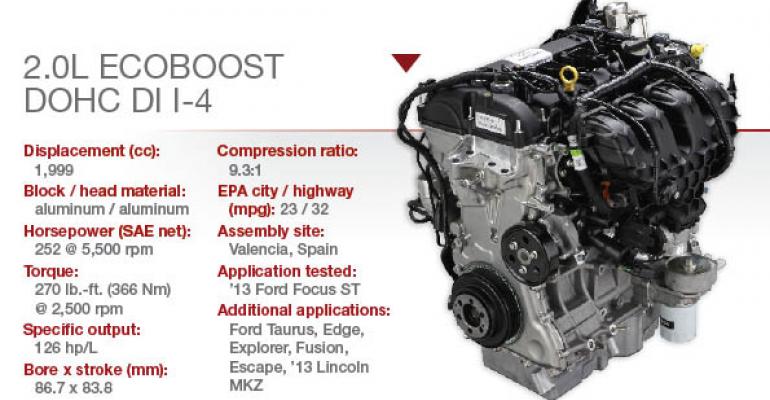The takeaway from this year’s Ward’s 10 Best Engines competition is straightforward: Auto makers are creating more power-dense small engines and showcasing them in a growing number of vehicles that have been optimized for light weight.
The Subaru BRZ and Cadillac ATS are prime examples, as is another winner this year, Ford’s 2.0L EcoBoost in the Focus ST. This hot hatchback weighing 3,223 lbs. (1,462 kg) draws 252 hp and 270 lb.-ft. (366 Nm) of thrust (with 93-octane fuel) from a diminutive 4-cyl. with gasoline direct injection and low-inertia turbocharging.
That torque peak arrives relatively early in the powerband – 2,500 rpm. But the Focus ST integrates an “overboost” feature that lets the driver wring out 7.4% more torque between 3,000 and 4,500 rpm by spinning up the single-scroll turbocharger for up to 15 seconds at a time.
 The reviews were near unanimous among WardsAuto editors driving the 2.0L EcoBoost in the Focus ST.
The reviews were near unanimous among WardsAuto editors driving the 2.0L EcoBoost in the Focus ST.
“It’s the perfect amount of horsepower for this car – tons of fun,” writes editor Byron Pope on his score sheet. “It’s one of the best car/engine combos in this year’s competition, with great low-end torque. It launches like a rocket.”
As strong as the Focus ST is, what clinched this year’s trophy was the 2.0L EcoBoost’s unexpectedlyrobust performance in a car that is 741 lbs. (336 kg) heavier: the Taurus.
V-8s used to be the norm in cars this size, but today’s EcoBoost with half the cylinders motivates the fullsize family sedan and its cavernous trunk with no problem at all.
WardsAuto editors logged 440 miles (708 km) while evaluating the Taurus, and two of them exceeded 24 mpg (9.8 L/100 km) – not bad for a big car. Mileage was slightly better in the Focus ST, which invited more spirited explorations of the potential boost.
If the goal is to consume less fuel, then a light foot on the accelerator is necessary when driving both the Taurus and Focus ST, to keep the turbocharger from working as little as possible. Both cars are rated at 32 mpg (7.3 L/100 km) on the highway.
The engine breathes with the help of a lightweight composite intake manifold and cam cover, as well as an exhaust manifold integrated within the cylinder head, which reduces time-to-torque and shortens warm-up.
Twin-independent variable cam timing, fast becoming a staple in Ford’s engine portfolio, provides precise control of intake and exhaust valves and internal exhaust-gas recirculation to boost fuel economy and idle quality.
The 2.0L EcoBoost’s greatest attribute is its flexibility, now powering the Fusion and ’13 Lincoln MKZ sedans, Escape cross/utility vehicle and even portlier Explorer and Edge utility vehicles.
The Focus ST is the sportiest EcoBoost application yet, featuring an electronically controlled “sound symposer” to amplify throaty frequencies from the intake manifold within the cabin to enhance the high-energy experience. Meanwhile, at idle the 2.0L EcoBoost in the Focus ST is “cemetery-quiet,” notes WardsAuto editor Jim Irwin.
Ford has won Ward’s 10 Best Engines trophies for EcoBoost engines in three of the last four years they have been available in the U.S.
Yet another EcoBoost powerplant arrives soon in the Fiesta, a 1.0L 3-cyl. engine that is awfully impressive. That engine will be in the hunt next fall for the 2014 competition.





